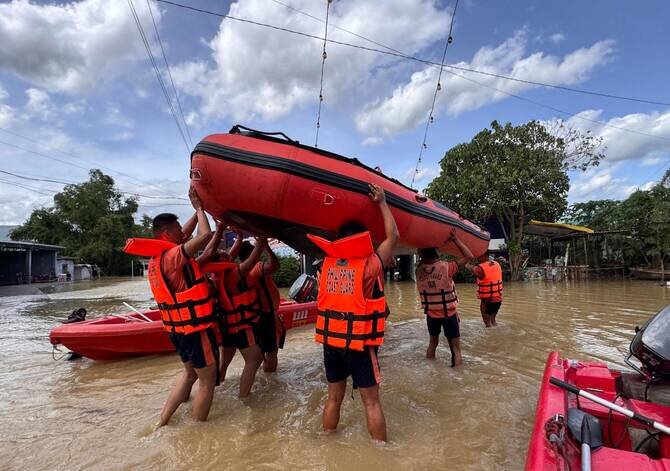
Taiwan Evacuates Thousands Ahead of Tropical Storm Fung-wong Following Deadly Philippines Landfall
Over 3,000 people evacuated in Taiwan as tropical storm Fung-wong approaches.
Taiwan has initiated evacuations for more than 3,000 individuals from vulnerable regions and closed schools and offices in preparation for the arrival of Tropical Storm Fung-wong.
The storm is expected to make landfall on Wednesday afternoon or evening near Kaohsiung, a major port city in southwestern Taiwan.
As of Tuesday morning, Fung-wong was noted to have maximum sustained winds reaching up to 108 kph (67 mph) with gusts as high as 137 kph (85 mph).
The storm is anticipated to traverse the island and exit through its northeastern side by Wednesday evening or early Thursday, according to Taiwan's weather agency.
The evacuations are particularly significant in areas like Guangfu township where recent typhoon-related flooding led to a barrier lake overflow, resulting in 18 fatalities last September.
As a precautionary measure, schools and offices have been shut down in Hualien and Yilan counties.
Weather authorities have issued a land warning that encompasses southern and southwestern regions including Kaohsiung, Pingtung County, Tainan, and Taitung.
China has also activated its emergency typhoon response for the southeastern provinces of Fujian, Guangdong, Zhejiang, and Hainan in anticipation of Fung-wong's impact on these areas.
Fung-wong made landfall in the Philippines on Sunday as a super typhoon with winds of up to 185 kph (115 mph) and gusts reaching 230 kph (143 mph).
The storm has caused widespread destruction across northern provinces, claiming at least 18 lives.
Over 1.4 million people have been displaced, with approximately 803,000 seeking refuge in evacuation centers spread across the northern Luzon region.
The Philippines' Office of Civil Defense reported these figures.
This event serves as a stark reminder of the annual vulnerability both Taiwan and the Philippines face from typhoons and storms.
Fung-wong's path through these regions underscores the necessity for preparedness measures to mitigate the impact of such natural disasters.
The storm is expected to make landfall on Wednesday afternoon or evening near Kaohsiung, a major port city in southwestern Taiwan.
As of Tuesday morning, Fung-wong was noted to have maximum sustained winds reaching up to 108 kph (67 mph) with gusts as high as 137 kph (85 mph).
The storm is anticipated to traverse the island and exit through its northeastern side by Wednesday evening or early Thursday, according to Taiwan's weather agency.
The evacuations are particularly significant in areas like Guangfu township where recent typhoon-related flooding led to a barrier lake overflow, resulting in 18 fatalities last September.
As a precautionary measure, schools and offices have been shut down in Hualien and Yilan counties.
Weather authorities have issued a land warning that encompasses southern and southwestern regions including Kaohsiung, Pingtung County, Tainan, and Taitung.
China has also activated its emergency typhoon response for the southeastern provinces of Fujian, Guangdong, Zhejiang, and Hainan in anticipation of Fung-wong's impact on these areas.
Fung-wong made landfall in the Philippines on Sunday as a super typhoon with winds of up to 185 kph (115 mph) and gusts reaching 230 kph (143 mph).
The storm has caused widespread destruction across northern provinces, claiming at least 18 lives.
Over 1.4 million people have been displaced, with approximately 803,000 seeking refuge in evacuation centers spread across the northern Luzon region.
The Philippines' Office of Civil Defense reported these figures.
This event serves as a stark reminder of the annual vulnerability both Taiwan and the Philippines face from typhoons and storms.
Fung-wong's path through these regions underscores the necessity for preparedness measures to mitigate the impact of such natural disasters.